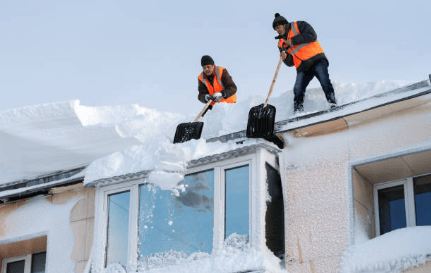The easiest way to get a layer of snow off your roof is to use a roof rake. The benefits of removing the snow is to prevent ice dams and reduce the heaviness that weighs the roof down. Roofing in older homes needs it more because of age.
New and old houses with flat roofs need it because the even surface holds more snow, weakening the roof’s structure. Newer homes with sloped roofing may not need cleaning, but it is still helpful if you do. Follow these tips to rake the snow off the roof without damaging the roof itself.
What Is a Roof Rake?
A roof rake looks like a garden hoe that is mounted on a long, telescoping pole to reach the roof of a one-story home from the ground. It is designed to gently remove the snow by pushing or pulling it off your roof.
A roof rake or snow rake keeps the roof safe from damage. It has an extended metal handle to clean the highest slopes and areas. However, the wrong rake type can cause more destruction than leaving it alone. Roof rakes with metal scraping material or pointy corners should never touch the roof. Not only will it scrape some roofing material off, but it will also cause electrical shock around power lines.
Buy a snow or roof rake with plastic or poly-edged rollers or bumpers. It should have rounded edges, too. An alternative to using a snow rake is a plastic shovel.
1. Rake in Sections
Start near the edge or overhang and remove the top layers of snow. Gently pull snow toward you and let it fall to the ground. Move upward in small sections or batches to pull more snow layers off the roof. Controlled movement is the correct way to remove snow. That helps snow fall from the roof safely.
Gathering snow in a pile before disposing of it will damage the roof when you use force on the rake. Raking snow from top to bottom brings too much snow to the edge, making it harder to move.
2. Keep Some Snow on the Roof
Keeping one to three inches of snow on the roof is a good idea. That prevents broken roof material and damaged roof protrusions. Additionally, it protects the roof from significant damage. Removing every inch of snow can lead to water damage, fungus growth, and structural collapse.
3. Be Careful Around Protrusions and Items Above the Roof
This is where looking before you scrape is crucial. Avoid removing snow near skylights and antennas, as they damage easily upon contact. Be cautious as you remove snow near gutters, downspouts, chimneys, and exhaust vents. Scraping too hard can rip gutters and downspouts from the hinges. Contact Aspen Roofing Services for gutter and downspout cleaning and repair in Peabody, MA. Incorrect cleaning causes leaks and damage to chimney flashing and exhaust vents.
Another thing to look for is power lines near or above the roof. You risk electrical shock and power outages when your snow rake bumps or tangles into power lines.
4. Rake in Moderation
The quote “too much of a good thing” applies to snow raking. The most careful homeowners raking snow from the roof can cause damage to it because of frequent raking. That eventually leads to cracks, holes, tears, and granule loss.
Pieces of granules are lost every time you remove snow from the roof. The fire-resistant roof material protects the roof from UV rays. Without that protection, the roofing fades, dries out, blisters, and deteriorates. That leads to water leaks, fungus growth, and a weakened structure. Rake your roof once or twice a year. Less is more.
5. Don’t Melt the Snow Yourself
You only need to rake the snow on the roof as far as you can reach from the ground with the roof rake. Remember that ice dams only form near the base of the roof. Then, you can let the remainder of the snow melt. The sun may take forever to melt it, but at least it won’t damage the roof.
Heat and harsh chemicals will melt the snow at the expense of your roof. Blow dryers, torches, heat guns, heat cables, and similar devices melt the snow too quickly, causing floods and avalanches. They also ignite fires, jeopardizing yourself, your family, and the neighborhood.
Meanwhile, harsh chemicals eat at the roof’s structure to create holes, which cause leaks and eventual water damage. Other things to avoid are rock salt, sharp objects, metal materials, and mechanical equipment. That includes ice picks, chisels, and hammers.
We Will Clear Your Roof of Snow Safely
Aspen Roofing Services are the expert roofers in Peabody to call on for every season. We understand the hazards of snow on roofs. We have the expertise and technology to remove it safely without damaging essential roofing components. We will clean gutters, downspouts, and roof drains from snow and ice clogs. In addition, our roofers can repair or replace damaged residential and commercial roofs. Contact Aspen Roofing Services for more information on services covered in Boston and the North Shore area.


